MITSUBISHI MIRAGE G4 2017 Owner's Manual (in English)
Manufacturer: MITSUBISHI, Model Year: 2017, Model line: MIRAGE G4, Model: MITSUBISHI MIRAGE G4 2017Pages: 307, PDF Size: 9.02 MB
Page 261 of 307
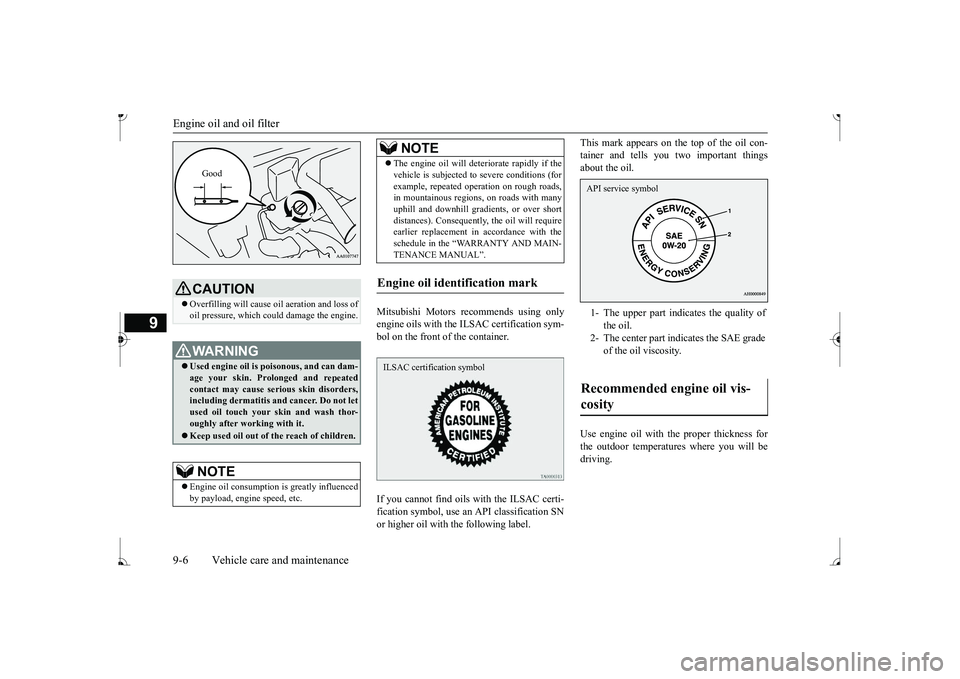
Engine oil and oil filter 9-6 Vehicle care and maintenance
9
Mitsubishi Motors recommends using only engine oils with the ILSAC certification sym- bol on the front of the container. If you cannot find oils
with the ILSAC certi-
fication symbol, use an API classification SN or higher oil with the following label.
This mark appears on the top of the oil con- tainer and tells you two important thingsabout the oil. Use engine oil with the proper thickness for the outdoor temperatures where you will bedriving.
CAUTION Overfilling will cause oil aeration and loss of oil pressure, which coul
d damage the engine.
WA R N I N GUsed engine oil is po
isonous, and can dam-
age your skin. Prolonged and repeatedcontact may cause serious skin disorders, including dermatitis and cancer. Do not let used oil touch your sk
in and wash thor-
oughly after working with it. Keep used oil out of
the reach of children.
NOTE
Engine oil consumption
is greatly influenced
by payload, engine speed, etc.
Good
The engine oil wi
ll deteriorate rapidly if the
vehicle is subj
ected to severe conditions (for
example, repeated operation on rough roads,in mountainous regions, on roads with many uphill and downhill gradients, or over short distances). Consequently
, the oil will require
earlier replacement in accordance with the schedule in the “WARRANTY AND MAIN- TENANCE MANUAL”.NOTE
ILSAC certification symbol
1- The upper part indicates the quality of
the oil.
2- The center part i
ndicates the SAE grade
of the oil viscosity.
Recommended engine oil vis- cosity API service symbol
BK0236100US.book 6 ページ 2016年2月1日 月曜日 午前10時15分
Page 262 of 307
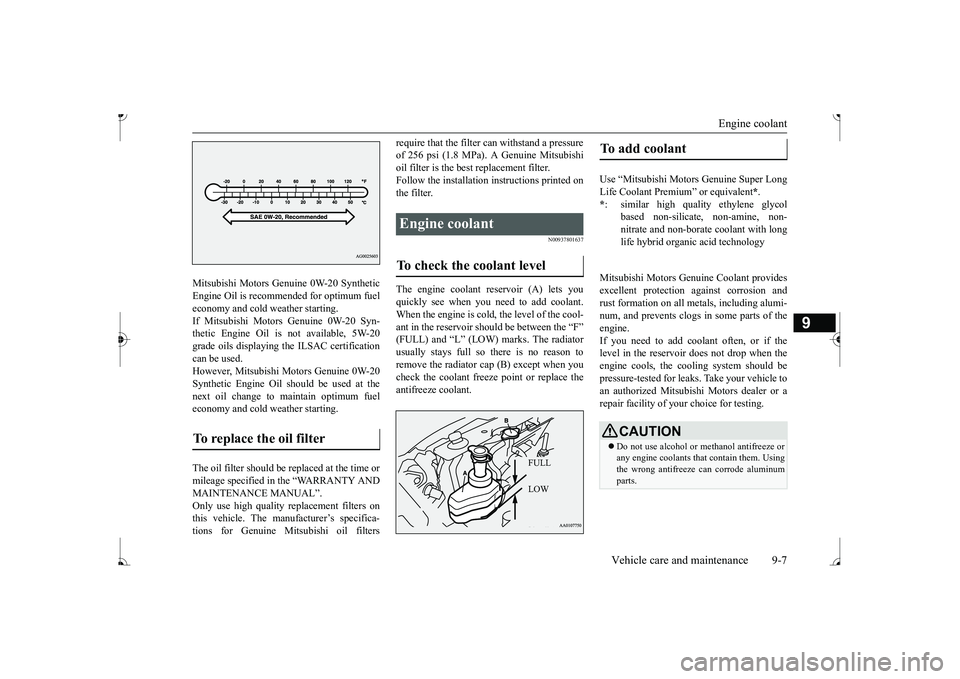
Engine coolant
Vehicle care and maintenance 9-7
9
Mitsubishi Motors Genui
ne 0W-20 Synthetic
Engine Oil is recommended for optimum fueleconomy and cold weather starting. If Mitsubishi Motors Genuine 0W-20 Syn- thetic Engine Oil is not available, 5W-20grade oils displaying th
e ILSAC certification
can be used. However, Mitsubishi Motors Genuine 0W-20Synthetic Engine Oil s
hould be used at the
next oil change to maintain optimum fuel economy and cold weather starting. The oil filter should be replaced at the time or mileage specified in the “WARRANTY ANDMAINTENANCE MANUAL”. Only use high quality
replacement filters on
this vehicle. The manufacturer’s specifica-tions for Genuine Mitsubishi oil filters
require that the filter can withstand a pressure of 256 psi (1.8 MPa). A Genuine Mitsubishioil filter is the best replacement filter. Follow the installation instructions printed on the filter.
N00937801637
The engine coolant reservoir (A) lets youquickly see when you need to add coolant.When the engine is cold
, the level of the cool-
ant in the reservoir should be between the “F”usually stays full so there is no reason to remove the radiator cap (B) except when you check the coolant freeze point or replace theantifreeze coolant.
Mitsubishi Motors Genuine Coolant provides excellent protection
against corrosion and
rust formation on all me
tals, including alumi-
num, and prevents clogs in some parts of theengine. If you need to add coolant often, or if the level in the reservoir does not drop when theengine cools, the c
ooling system should be
pressure-tested for leaks. Take your vehicle to an authorized Mitsubishi Motors dealer or arepair facility of your
choice for testing.
To replace the oil filter
Engine coolant To check the coolant level
FULL LOW
To add coolant Use “Mitsubishi Motors
Genuine Super Long
Life Coolant Premium” or equivalent
*.
* : similar high quality
ethylene glycol
based non-silicate
, non-amine, non-
nitrate and non-borate coolant with long life hybrid organic acid technologyCAUTION Do not use alcohol or
methanol antifreeze or
any engine coolants th
at contain them. Using
the wrong antifreeze can corrode aluminum parts.
BK0236100US.book 7 ページ 2016年2月1日 月曜日 午前10時15分
Page 263 of 307
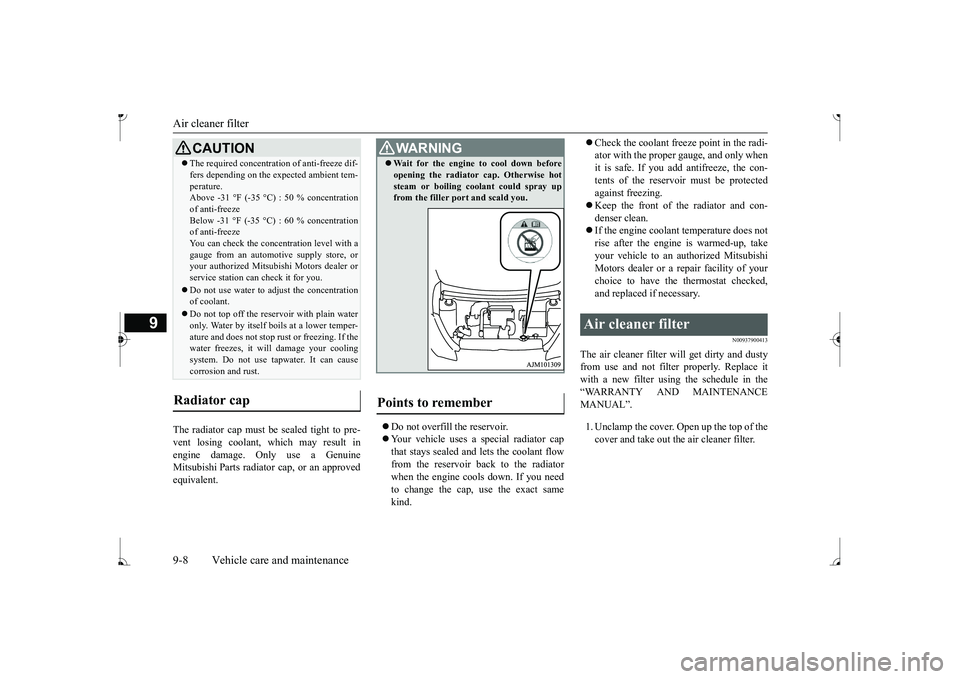
Air cleaner filter 9-8 Vehicle care and maintenance
9
The radiator cap must be
sealed tight to pre-
vent losing coolant, which may result in engine damage. Only use a Genuine Mitsubishi Parts radiator
cap, or an approved
equivalent.
Do not overfill the reservoir. Your vehicle uses a special radiator cap that stays sealed and lets the coolant flow from the reservoir back to the radiatorwhen the engine cools down. If you need to change the cap, use the exact same kind.
Check the coolant freeze point in the radi- ator with the proper gauge, and only whenit is safe. If you add antifreeze, the con- tents of the reservoi
r must be protected
against freezing. Keep the front of the radiator and con- denser clean. If the engine coolan
t temperature does not
rise after the engine
is warmed-up, take
your vehicle to an au
thorized Mitsubishi
Motors dealer or a repair facility of your choice to have the thermostat checked, and replaced if necessary.
N00937900413
The air cleaner filter
will get dirty and dusty
from use and not filter
properly. Replace it
with a new filter using the schedule in the “WARRANTY AND MAINTENANCE MANUAL”. 1. Unclamp the cover. Open up the top of the cover and take out th
e air cleaner filter.
The required concentrati
on of anti-freeze dif-
fers depending on the
expected ambient tem-
perature.Above -31 °F (-35 °C) : 50 % concentration of anti-freeze Below -31
Page 264 of 307

Manual transaxle oil (if so equipped) Vehicle care and maintenance 9-9
9
2. Replacing the air clea
ner filter and put the
cover back on in its original position.
N00938200181
Whenever the manual transaxle oil level ischecked, add oil to maintain the proper level,if necessary. Refill or change with the oil according to the table below.
N00938101129
The continuously variable transmission(CVT) should be maintained and serviced by an authorized Mitsubishi Motors dealer or a repair facility of your choice to obtain thebest performance and longest life. It is impor-
tant that the transmission fluid is kept at the correct level. Use only “Mitsubish
i Motors Genuine
CVTF-J4” transmission fluid to ensure opti-mum transmission performance. Do not use any fluid additives to the trans- mission.
N00938601371
The windshield washer
fluid reservoir is in
the engine compartment.
NOTE
Genuine Mitsubishi Moto
rs Parts are recom-
mended when replacing th
e air cleaner filter.
Make sure that the connector is properly reconnected. After replacing the air cleaner filter, make sure that the hinges at the bottom of coverare firmly set.CAUTION Take care not to scra
tch the engine air flow
sensor when removing
the air cleaner cover.
Manual transaxle oil
(if so
equipped)
Lubricant
Mitsubishi Motors Genuine NEW MULTI GEAR OIL ECO API Classifica-
tion GL-4
Viscosity range SAE 75W-80
Continuously variable transmission (CVT) fluid
(if
so equipped)
CAUTION Using the improper transaxle fluid may dam- age the transaxle.
Special additives
Washer fluid
BK0236100US.book 9 ページ 2016年2月1日 月曜日 午前10時15分
Page 265 of 307
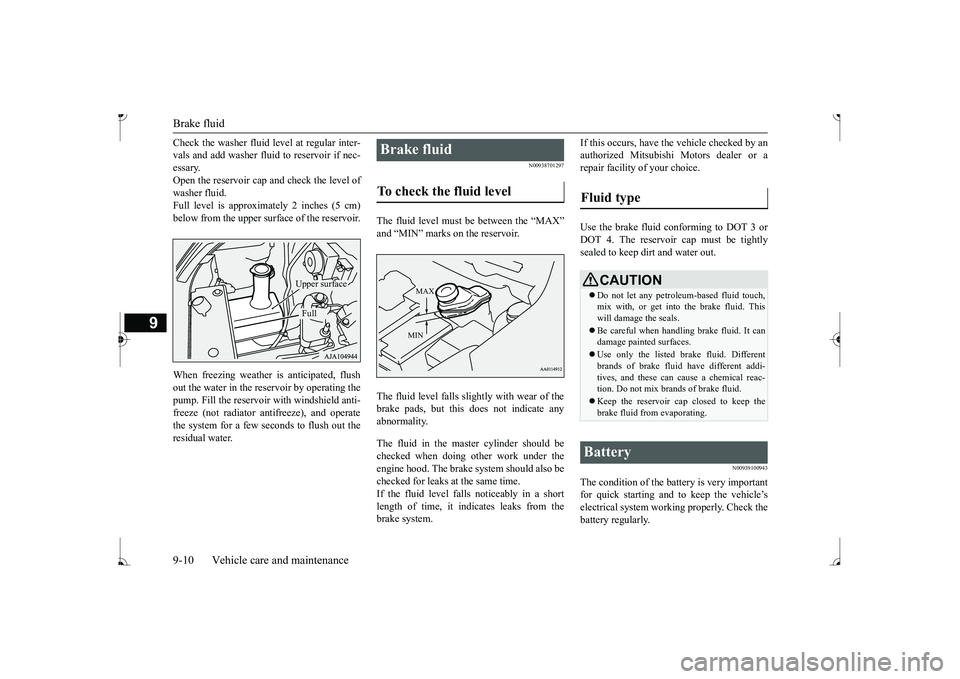
Brake fluid 9-10 Vehicle care and maintenance
9
Check the washer fluid
level at regular inter-
vals and add washer fluid to reservoir if nec-essary. Open the reservoir cap and check the level of washer fluid.Full level is approximately 2 inches (5 cm) When freezing weather is anticipated, flush out the water in the reservoir by operating the pump. Fill the reservoir with windshield anti-freeze (not radiator an
tifreeze), and operate
the system for a few seconds to flush out the residual water.
N00938701297
The fluid level must be between the “MAX” The fluid level falls slightly with wear of the brake pads, but this
does not indicate any
abnormality. The fluid in the master cylinder should be checked when doing other work under the engine hood. The brake system should also bechecked for leaks at the same time. If the fluid level falls
noticeably in a short
length of time, it indi
cates leaks from the
brake system.
If this occurs, have the vehicle checked by an authorized Mitsubishi Motors dealer or arepair facility of your choice. Use the brake fluid conforming to DOT 3 or DOT 4. The reservoir cap must be tightly sealed to keep dirt and water out.
N00939100943
The condition of the battery is very important for quick starting and to keep the vehicle’selectrical system working properly. Check the battery regularly.
Upper surface Full
Brake fluid To check the fluid level
MAX MIN
Fluid type
CAUTION Do not let any petrol
eum-based fluid touch,
mix with, or get into
the brake fluid. This
will damage the seals. Be careful when handli
ng brake fluid. It can
damage painted surfaces. Use only the listed brake fluid. Different brands of brake fluid
have different addi-
tives, and these can cause a chemical reac- tion. Do not mix brands of brake fluid. Keep the reservoir cap closed to keep the brake fluid from evaporating.
Battery
BK0236100US.book 10 ページ 2016年2月1日 月曜日 午前10時15分
Page 266 of 307
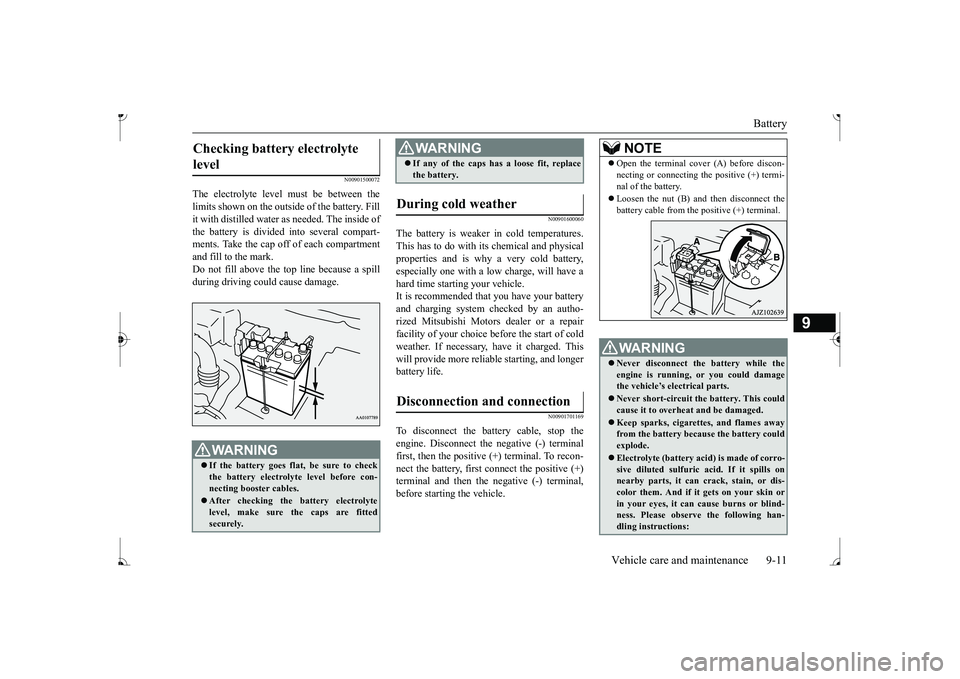
Battery
Vehicle care and maintenance 9-11
9
N00901500072
The electrolyte level
must be between the
limits shown on the outside of the battery. Fillit with distilled water as needed. The inside of the battery is divided into several compart- ments. Take the cap off of each compartmentand fill to the mark. Do not fill above the top line because a spill during driving could cause damage.
N00901600060
The battery is weaker in cold temperatures. This has to do with its chemical and physical properties and is why a very cold battery,especially one with a lo
w charge, will have a
hard time starting your vehicle. It is recommended that you have your batteryand charging system checked by an autho- rized Mitsubishi Motors dealer or a repair facility of your choice before the start of coldweather. If necessary, have it charged. This will provide more relia
ble starting, and longer
battery life.
N00901701169
To disconnect the battery cable, stop theengine. Disconnect the
negative (-) terminal
first, then the positive (+) terminal. To recon- nect the battery, first
connect the positive (+)
terminal and then the negative (-) terminal,before starting the vehicle.
Checking battery electrolyte level
WA R N I N G If the battery goes flat, be sure to check the battery electrolyte level before con- necting booster cables. After checking the battery electrolyte level, make sure the caps are fittedsecurely.
If any of the caps has a loose fit, replace the battery.
During cold weather Disconnection and connection
WA R N I N G
NOTE
Open the terminal cover (A) before discon- necting or connecting the positive (+) termi-nal of the battery. Loosen the nut (B) and then disconnect the battery cable from the positive (+) terminal.WA R N I N G Never disconnect the battery while the engine is running,
or you could damage
the vehicle’s electrical parts. Never short-circuit the battery. This could cause it to overhea
t and be damaged.
Keep sparks, cigarettes, and flames away from the battery because the battery couldexplode. Electrolyte (battery acid) is made of corro- sive diluted sulfuric acid. If it spills on nearby parts, it can crack, stain, or dis- color them. And if it
gets on your skin or
in your eyes, it can cause burns or blind- ness. Please observe the following han- dling instructions:
BK0236100US.book 11 ページ 2016年2月1日 月曜日 午前10時15分
Page 267 of 307
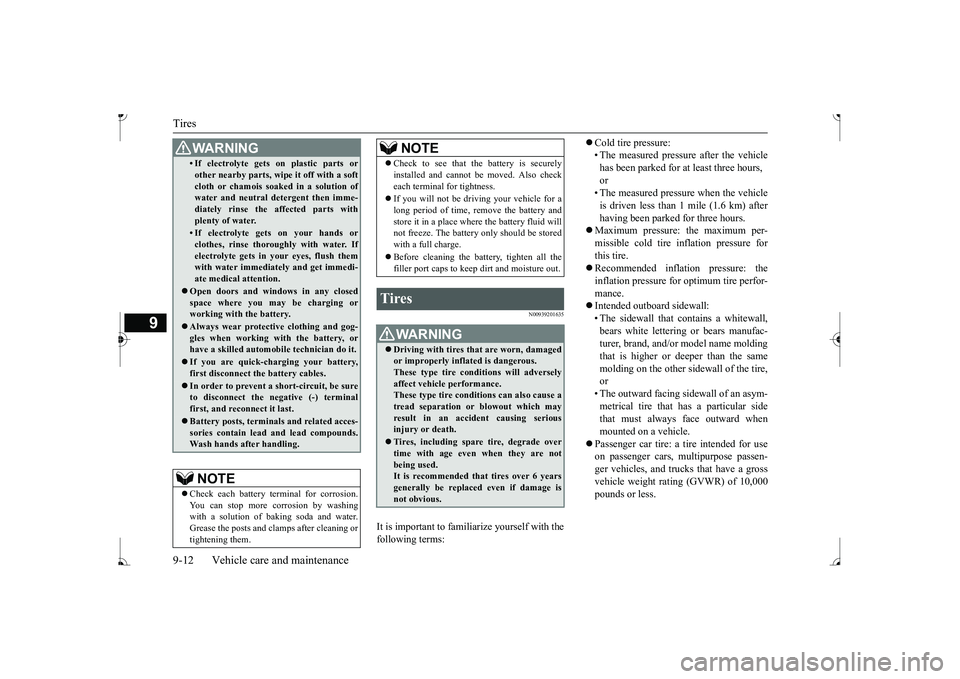
Tires 9-12 Vehicle care and maintenance
9
N00939201635
It is important to fami
liarize yourself with the
following terms:
Cold tire pressure: • The measured pressure after the vehiclehas been parked for
at least three hours,
or • The measured pressure when the vehicleis driven less than 1 mile (1.6 km) after having been parked for three hours.
Maximum pressure: the maximum per- missible cold tire inflation pressure for this tire. Recommended inflation pressure: the inflation pressure for optimum tire perfor- mance. Intended outboard sidewall: • The sidewall that
contains a whitewall,
bears white lettering or bears manufac-turer, brand, and/or model name molding that is higher or deeper than the same molding on the other sidewall of the tire,or • The outward facing sidewall of an asym- metrical tire that has a particular sidethat must always face outward when mounted on a vehicle.
Passenger car tire: a tire intended for use on passenger cars,
multipurpose passen-
ger vehicles, and trucks
that have a gross
vehicle weight rating (GVWR) of 10,000pounds or less.
• If electrolyte gets on plastic parts or other nearby parts, wipe it off with a softcloth or chamois soak
ed in a solution of
water and neutral detergent then imme- diately rinse the affected parts with plenty of water.• If electrolyte gets on your hands orclothes, rinse thoroughly with water. Ifelectrolyte gets in
your eyes, flush them
with water immediately and get immedi- ate medical attention.
Open doors and wind
ows in any closed
space where you may be charging orworking with the battery. Always wear protective clothing and gog- gles when working with the battery, or have a skilled automobi
le technician do it.
If you are quick-charging your battery, first disconnect the battery cables. In order to prevent a
short-circuit, be sure
to disconnect the negative (-) terminal first, and reconnect it last. Battery posts, terminals and related acces- sories contain lead
and lead compounds.
Wash hands after handling.NOTE
Check each battery terminal for corrosion. You can stop more corrosion by washingwith a solution of baking soda and water. Grease the posts and cl
amps after cleaning or
tightening them.WA R N I N G
Check to see that the battery is securely installed and cannot be
moved. Also check
each terminal for tightness. If you will not be driv
ing your vehicle for a
long period of time, re
move the battery and
store it in a place where the battery fluid will not freeze. The batter
y only should be stored
with a full charge. Before cleaning the ba
ttery, tighten all the
filler port caps to keep
dirt and moisture out.
Tires
WA R N I N GDriving with tires that are worn, damaged or improperly infl
ated is dangerous.
These type tire conditions will adverselyaffect vehicle performance. These type tire conditions can also cause a tread separation or blowout which mayresult in an accident causing serious injury or death. Tires, including spar
e tire, degrade over
time with age even when they are not being used. It is recommended that tires over 6 yearsgenerally be replaced
even if damage is
not obvious.NOTE
BK0236100US.book 12 ページ 2016年2月1日 月曜日 午前10時15分
Page 268 of 307

Tires
Vehicle care and maintenance 9-13
9
Light truck (LT) tire: a tire designated by its manufacturer as primarily intended foruse on lightweight truc
ks or multipurpose
passenger vehicles. Tread: portion of a tire that comes into contact with the road. Tread rib: a tread se
ction running circum-
ferentially around a tire. Tread separation: pulling away of the tread from the tire carcass. Carcass: the tire structure, except tread and sidewall rubber which, when inflated, bears the load. Sidewall: portion of
a tire between the
tread and bead. Section width: the lin
ear distance between
the exteriors of th
e sidewalls of an
inflated tire, excludi
ng elevations due to
labeling, decoration,
or protective bands.
Bead: the part of the tire that is made of steel wires, wrapped or reinforced by ply cords and that is shaped to fit the rim. Ply: a layer of rubber-coated parallel cords. Cord: the strands forming the plies in the tire. Rim: a metal support for a tire or a tire and tube assembly upon which the tirebeads are seated. Rim diameter: nominal diameter of the bead seat.
Groove: the space between two adjacent tread ribs.
EXAMPLE: P215/65R15Tire Markings 1- Size Designation 2- Service Description 3- Maximum Load 4- Maximum Pressure 5- U.S. DOT Safety Standards Code
(TIN)
6- Treadwear, Traction and Temperature
Grades
Size Designation P
Passenger car tire
size based on
U.S.A. design standards
215 Section width in millimeters (mm) 65
Aspect ratio in percent (%) Ratio of section height to section width of tire.
R
Construction code • “R” means radial construction. • “D” means diagon
al or bias con-
struction.
15 Rim diameter in inches (in)
NOTE
European/Japanese metric tire sizing is based on European/Japanese design standards. Tires designed to these standards have the tire size molded into the sidewall beginningwith the section width. The letter “P” is absent from this tire size designation. Example: 215/65R15 96H. LT (Light Truck) -metri
c tire sizing is based
on U.S.A. design standards. The size desig-nation for LT-metric tires is the same as for P-metric tires except for the letters “LT” that are molded into the sidewall preceding thesize designation. Example: LT235/85R16. Temporary spare tires are high pressure com- pact spares designed
for temporary emer-
gency use only. Tires designed to thisstandard have the letter “T” molded into the sidewall preceding th
e size designation.
Example: T145/80D18 103M.
BK0236100US.book 13 ページ 2016年2月1日 月曜日 午前10時15分
Page 269 of 307
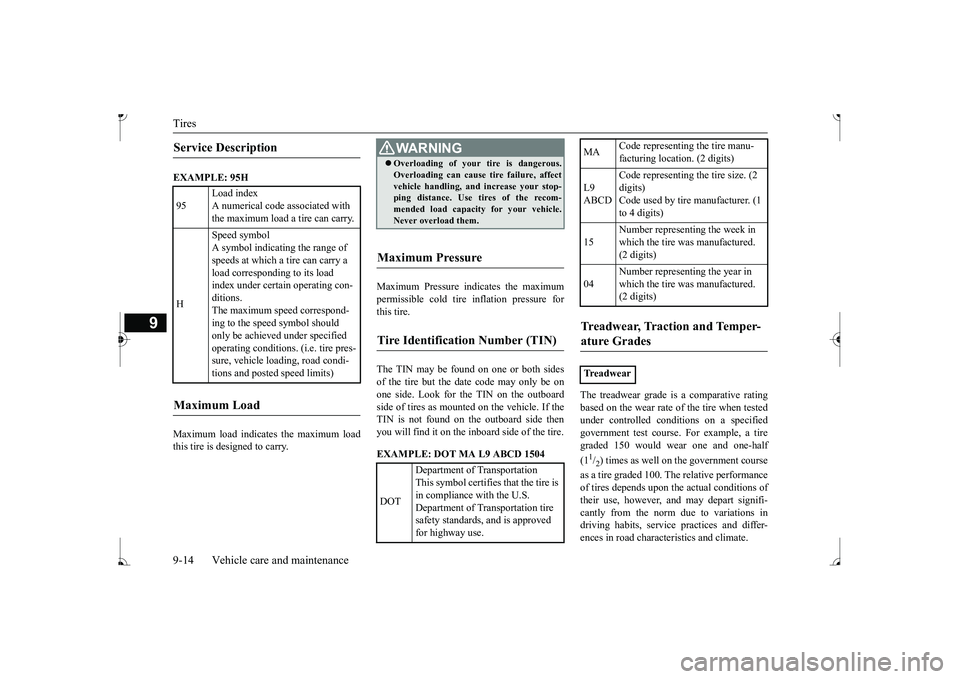
Tires 9-14 Vehicle care and maintenance
9
EXAMPLE: 95H Maximum load indicates the maximum load this tire is designed to carry.
Maximum Pressure indicates the maximum permissible cold tire
inflation pressure for
this tire. The TIN may be found on one or both sides of the tire but the da
te code may only be on
one side. Look for the TIN on the outboard side of tires as mounted
on the vehicle. If the
TIN is not found on the outboard side thenyou will find it on the inboard side of the tire. EXAMPLE: DOT MA L9 ABCD 1504
The treadwear grade is a comparative rating based on the wear rate of the tire when tested under controlled conditions on a specifiedgovernment test course
. For example, a tire
graded 150 would wear one and one-half (11/2) times as well on the government course
as a tire graded 100.
The relative performance
of tires depends upon the actual conditions oftheir use, however, and may depart signifi- cantly from the norm due to variations in driving habits, service practices and differ-ences in road characteristics and climate.
Service Description 95
Load index A numerical code associated with the maximum load a tire can carry.
H
Speed symbol A symbol indicating the range of speeds at which a tire can carry a load corresponding to its load index under certain operating con- ditions. The maximum speed correspond-ing to the speed symbol should only be achieved under specified operating conditions.
(i.e. tire pres-
sure, vehicle loading, road condi- tions and posted
speed limits)
Maximum Load
WA R N I N GOverloading of your tire is dangerous. Overloading can cause tire failure, affectvehicle handling, and increase your stop-ping distance. Use tires of the recom- mended load capacity for your vehicle. Never overload them.
Maximum Pressure Tire Identification Number (TIN) DOT
Department of Transportation This symbol certifies that the tire is in compliance with the U.S. Department of Tr
ansportation tire
safety standards,
and is approved
for highway use.
MA
Code representing the tire manu- facturing location. (2 digits)
L9 ABCD
Code representing th
e tire size. (2
digits) Code used by tire manufacturer. (1 to 4 digits)
15
Number representing the week in which the tire was manufactured. (2 digits)
04
Number representing the year in which the tire was manufactured. (2 digits)
Treadwear, Traction and Temper- ature Grades Tr e a d w e a r
BK0236100US.book 14 ページ 2016年2月1日 月曜日 午前10時15分
Page 270 of 307

Tires
Vehicle care and maintenance 9-15
9
The traction grades, from highest to lowest, are AA, A, B and C. Those grades representthe tire’s ability to
stop on wet pavement as
measured under controlled conditions on specified government te
st surfaces of asphalt
and concrete. A tire marked C may have poor traction performance. The temperature grades are A (the highest), B and C, representing the ti
re’s resistance to the
generation of heat and it
s ability to dissipate
heat when tested un
der controlled conditions
on a specified indoor
laboratory test wheel.
Sustained high temperature can cause the material of the tire to
degenerate and reduce
tire life, and excessive temperature can lead to sudden tire failure. The grade C corre- sponds to a level of
performance which all
passenger car tires must
meet under the Fed-
eral Motor Vehicle Safety Standard No. 109. Grades B and A represent higher levels ofperformance on the laboratory test wheel than the minimum required by law.
N00939301984
Proper tire inflation pre
ssure is essential for
the safe and satisfac
tory operation of your
vehicle. The wrong tire pressure will cause problems in three major areas: Safety Too little pressure increases flexing in the tire and can cause tire failure. Too much pressure can cause a tire to lose its abilityto cushion shock. Objects on the road and potholes could then cause tire damage that may result in tire failure. Economy The wrong tire pressure can cause uneven wear patterns in the tire tread. These abnormal wear patterns will reduce the tread life, and the tire will have to bereplaced sooner. Too little pressure also
makes it harder for
the tire to roll, and this uses up more fuel. Ride comfort and vehicle stability The superior riding ex
perience built into
your vehicle partly depends on the correcttire pressure. Too much pressure gives an uncomfortable and ja
rring ride. Too little
pressure feels as if
your vehicle is slow to
respond. Unequal tire pressure
s can make steering
your vehicle uneven
and unpredictable.
The tire pressure for your vehicle under nor- mal driving conditions is listed on the placard attached to the driver’s door sill. (Refer to “Tire and loading information plac-ard” on page 11-3.)
The recommended infl
ation pressures under
normal driving conditions should be used forthe tires listed below. Tire pressures should be checked, and adjusted if necessary,
at least once a month.
Pressures should be checked more often whenever weather temperatures changeseverely, becaus
e tire pressures change with
outdoor temperatures. The pressures listed are always “cold inflation pressure”.Cold inflation pressure is measured after the vehicle has been parked
for at least three
hours or is driven less than 1 mile (1.6 km)after having been parked for three hours. Cold inflation pressure
must not go above the
maximum values molded into the tire side-wall. After driving se
veral miles, your tire
inflation pressure may increase 2 to 6 psi (14 to 41 kPa) from the cold inflation pressure.Do not let air out of the tires to get back to the
Traction TemperatureTire inflation pressures
Item
Tire size
Front
Rear
Normal tire
165/65R14
240 kPa, 35 psi
240 kPa, 35 psi
175/55R15
220 kPa, 32 psi
220 kPa, 32 psi
Compact spare wheel
T115/70D14 420 kPa, 60 psi
BK0236100US.book 15 ページ 2016年2月1日 月曜日 午前10時15分